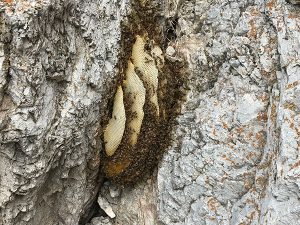Since 2008 when Africanized honey bee (AHB) Apis mellifera scutellata (Lepeletier) was first detected in Southern Utah, the UDAF Apiary Program has monitored its spread through the state. In Utah, there have only been a few instances of AHB attacking humans or animals. Nevertheless, if a person has no experience managing bees, it is best practice to keep clear of any encountered honey bees and to treat all colonies with the respect they deserve.
The counties with known established AHB populations are Emery, Garfield, Grand, Iron, Kane, San Juan, Washington, and Wayne. A single sample of bees collected in Sevier County in 2023 tested positive as Africanized. However, the county is not considered to have established AHB populations yet. Further survey and testing will be conducted to determine the county’s AHB status. State inspectors continue to track movement to new areas by testing bees from managed and feral colonies in un-infested counties. UDAF is committed to ensuring that all stakeholders are made aware whenever AHB moves into a new county.
If you have additional questions or concerns regarding AHB please contact the UDAF Apiary Program at (801) 982-2313 or UDAF-insects@utah.gov.
Outdoor Recreation Safety
Guidelines for avoiding Africanized honey bee attacks during outdoor recreation
- Always stay alert. Among a variety of venomous creatures in Utah, the Africanized honey bee is only one potential hazard.
- Look for honey bee colonies when outdoors. Honey bees nest in a wide variety of locations. Be alert for groups of flying bees entering or leaving an entrance or opening and listen for buzzing sounds. Be especially alert when climbing, don’t put your hands where you can’t see them.
- Not all honey bees are a potential threat. Foraging bees may visit campsites for water, sweets, or flowers. As long as they are away from the nest, honey bees are usually not defensive. Yet, a large number of bees foraging in one area may indicate a colony is nearby. Look around for the colony before camping in that area.
- If you do find a colony of bees, leave them alone and keep others away. If it is near an area frequently used by the public, notify the local parks, Forest Service, BLM, or Department of Wildlife Resources office even if the bees seem docile.
- Keep your pets under control. If your pet disturbs a colony it is likely to bring the bees back to you.
- Wear light-colored clothing and avoid wearing scents.
- Be particularly careful when using equipment that produces vibrations or sound.
- If you know that you are allergic to bee stings, always have someone with you when doing outdoor activities and carry doctor-recommended medications with you at all times.
- If attacked by honey bees, run as far and as fast as possible. Pull your shirt up over your head to protect your face. Run to shelter. Do not enter the water because the bees may wait for you to surface for air. Remove all stingers by scraping them out once you reach shelter or outrun the bees. Seek medical attention if stung more than 15 times or if you have an allergic reaction.

Africanized honey bees cannot be visually distinguished from traditional European honey bees
Safety Tips for Schools
Guidelines for planning for Africanized Honey Bee (AHB) safety on and around campus
- Have a monitor regularly walk school grounds looking for bee swarms or colonies. Make sure the monitor knows how to spot a bee swarm or an established colony.
- Keep all holes in the ground and/or buildings filled or covered (1/8’’ hole or larger allows bee access). Common places include sprinkler boxes, sheds, attics, vents, etc.
- Areas off-campus should also be examined where students arrive and leave the school grounds.
- If a honey bee swarm or colony is detected, the faculty should be notified to keep everyone away from the area. Arrangements to remove the swarm/colony should be made even if the bees do not appear to be threatening.
- Noisy equipment such as lawnmowers or generators should be used when students are indoors or away from campus. Bees are often aggravated during landscape maintenance operations.
- Teach students to leave bees alone! If a colony is disturbed, encourage students to run indoors. Call 911 when there is a stinging emergency.
- Make sure the school nurse is ready. The nurse should be aware of proper stinger removal and the signs of allergic reactions. If possible have an anaphylactic kit, bee suit, and veil available for emergencies.
- Be prepared and prevent honey bee emergencies. Reassure students and faculty that most people won’t encounter AHBs and those that do are rarely seriously injured when an emergency protocol is followed.

Honey Bee Removal
Property owners that find a feral colony on their property should contact either a beekeeper or a pest control company for help. Property owners should not attempt to remove feral colonies on their own. A listing of beekeepers (alphabetically by city) willing to collect swarms of bees can be found here: https://beeremovalsource.com/bee-removal-list/utah/





